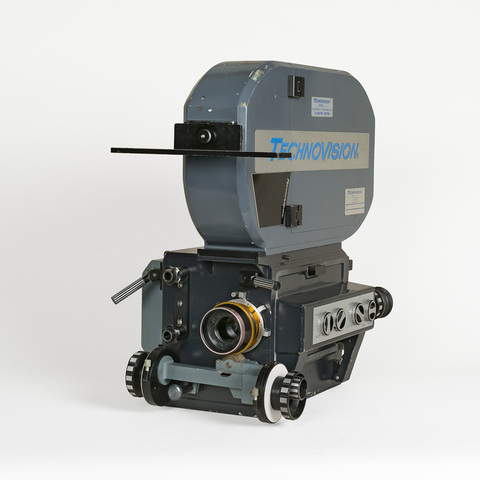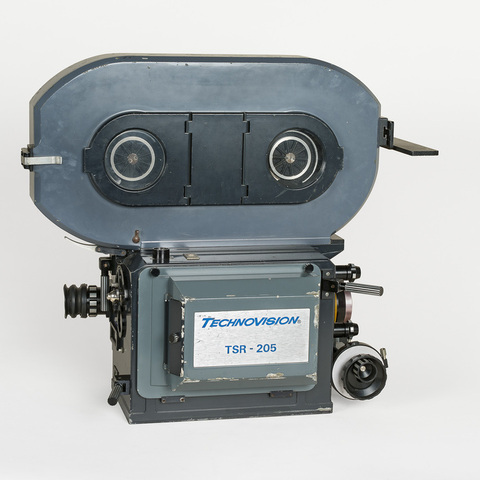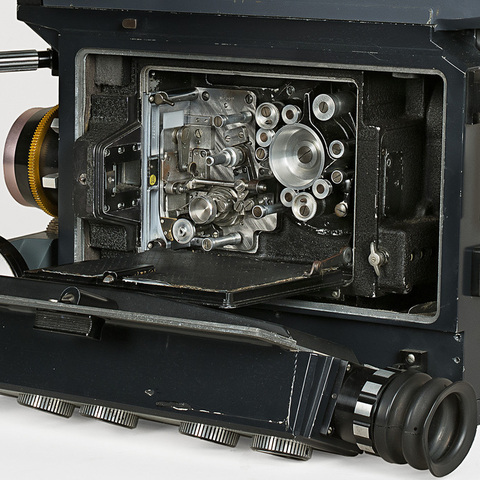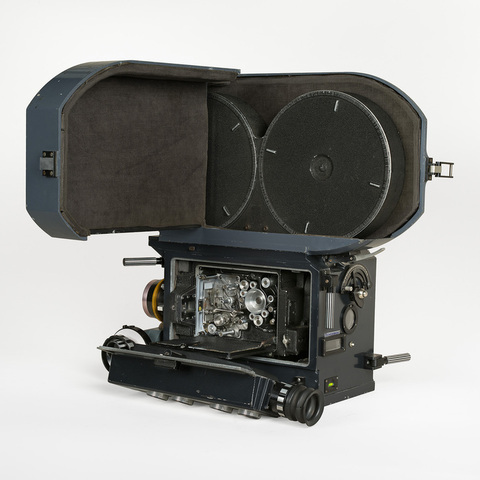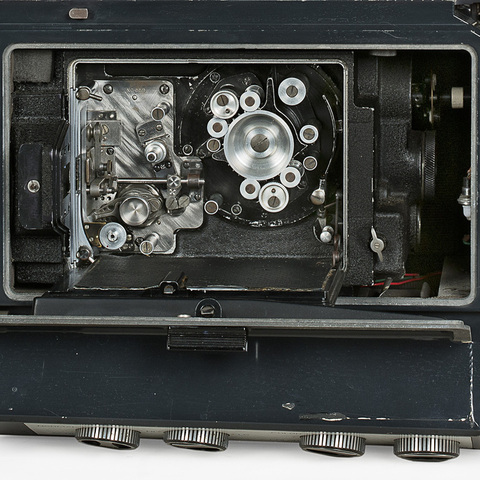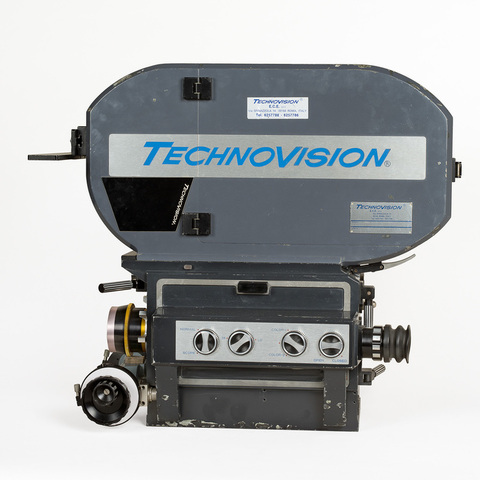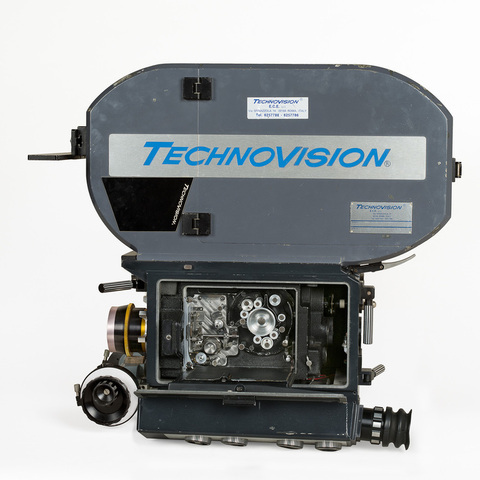Caméra film 35 mm
Fiche détaillée
Type de l'appareil
mécanisme Mitchell NC à entraînement du film 35 mm par deux griffes et deux contre-griffes ; un débiteur denté ; magasin débiteur et récepteur 300 mètres sous caisson insonore ; viseur reflex Magni Super Bright avec réglage scope ou normal ; obturateur 50-205° variable ; moteur électrique ; niveau à bulle
Auteurs
Chroscicki Henryk
Rome
Fabricants
Mitchell Camera Corporation
Hollywood, California
Technovision
Rome, Via Spinazzola 14
Utilisateurs
Chroscicki Henryk
Rome
Distributeurs
Technovision
Rome, Via Spinazzola 14
Sujet du modèle
Informations non disponibles
Objectif
null
Taille de l'objet
Ouvert :
Informations non disponibles
Fermé :
Longueur : 69 cm
Largeur : 40 cm
Hauteur : 61 cm
Diamètre :
Informations non disponibles
Taille de la boîte de transport
Informations non disponibles
Remarques
Marques : "Technovision TSR 205" ; Technovision E.C.E. s.r.l. Via Spinazzola 14, 00164 Roma, Italy, tel. 6257788 - 6257786".
"Technovision. The lightest, quietest, most beautiful silent reflex camera ever, TSR 205. Technovision's new TSR 205 is a compact sound stage camera, functionally designed around the well-known BNCR movement. It has the remarkable Technovision 205 degree variable shutter which both increases exposure by 14 per cent and reduces strobe effect during fast panning - thus allowing the cinematographer to take full advantage of the new technovision high speed lenses in low light situations. An alternative version of this splendid camera is the TSR 205 Cooke, in which only the shutter is different. This is a special fixed 205 degree shutter, which allows the use of Cooke, Zeiss Super Speed, 9.8 Kinoptic or standard BNCR-mounted lenses - the TSR 205 Cooke is the only studio reflex camera with this all-round ability. Among the many new features of the TSR 205 are fast over-centre action, magnetic latches, large adjustable marking scales on the follw focus and an oversize eyepiece - and an oven-fired paint finish for easy-care durability. And the latest technology in optical coatings and fast lenses goes to provide the most brilliant of viewing systems. So quiet, the TSR 205 registers just 28.5 db - an important consideration in top quality studio filming. Its weight - as low as possible to minimize fatigue - is only 34 kg, achieved by the use of precision hand-fitted magnesium castings and a featherweight crystal-regulated variable speed motor, superbly engineered. Shutter : ariable 50 - 205 degrees. Viewfinder : Magni Super Bright 4x magnification. Viewfinder filters : two neutral density filters incorporating 60 and 90. Blimp housing for magazines : 300 m. Matte box for two rectangular filters 101.6 mm x 101.6 mm and one circular filter 114.3 mm diameter. Blimp housing for Varotal : special fast-mounting blimp for large close-ups with cooke varotal zoom lens. Specification : TSR 205 Cooke camera all as for TSR 205, except : Shutter : special design 205 degree, fixed. Lenses : Cooke Speed Panchro, Zeiss Super Speed, Kinoptic 9.8, Cooke zooms and any standard BNCR mounted lenses. Accessories : 220 3-phase synchronous motor variable 8-32 fps or lightweight Technicraft crystal-controlled variable speed motor 30 v DC, 24/25 fps. Lightweight compact blimp for 120 m magazines. Unsqueezing lens and mounting for anamorphic viewfinder. Quick release balance plate and wedge for Worral, Moy, O'Connor or almost any head, compatible with all Mitchell BNCR-Type studio cameras" (Technovision TSR 205, England, s.d.).
"Henryk Chroscicki [1919 - 2000], born in Poland, grew up in Australia and has lived for the past 25 years in Rome, where he trained as a cameraman at the prestigious Centro Sperimentale. In 1954, wanting to shoot a film about Sicily's volcano, Mount Etna, he approached Fox for equipment. Fox had just introduced the Cinemascope process, but they would only allow their lens attachments to be used for feature films, not documentaries. Refusing to change his plans to shoot on anamorphic, Chroscicki then went direct to the home of anamorphics, France. [...] He was fortunate to be able to buy one of the ten Chrétien Hypergonar prototypes (an attachement for use on primary lenses from 50 mm to 100 mm) and was gratified to find - when he came to make that film on Etna - that it gave excellent definition, though distortion was a problem, as it was with Cinemascope. Therefater he started to lend his lens to colleagues. Requests to borrow it soon became so numerous that he decided to obtain the remaining prototypes from France and as a result unintentionally found himself in the camera rental business. But Chroscicki was also a pioneer. His French lenses may have produced a sharp image, but he remained dissatisfied with their tendency to distort the visuel image. So he set about finding his own answer to this technical drawback and by 1956, with the help of two of Chrétien's original collaborators, Chroscicki had developed Totalscope, the first camera/lens system to have a wide range of anamorphic lenses, from 32 mm to 150 mm, as well as two anamorphic zooms. [...] Cinemascope was put out of business in Europe and Totalscope secured 90 per cent of the market, servicing in the ten years to 1966 457 features, including Fellini's La Dolce Vita and Sergio Leone's The Colossus of Rhodes and more than 1000 documentaries. Totalscope had already serviced 150 features before Panavision was launched. But all anamorphic systems lost ground from 1966 onwards as they were superseded in Europe by Technicolor's new process, Techniscope. [...] In the early 1970's, his vision and commitment began to pay dividends. With the help of David Pringle, who brings to venture the technical expertise of a film-maker and the financial backing of American capital, Chroscicki launched Technovision, the first system finally to solve the twin problems of definition and distortion, and the one with the widest range of lenses, including high-speed anamorphics. [...] Technovision made its debut in 1974" (Technovision & Cooke Anamorphic, a complete filming system for the professional cinematographer, London, Technovision LTD, s.d.).
Bibliographie
Technovision TSR 205, England, s.d.
